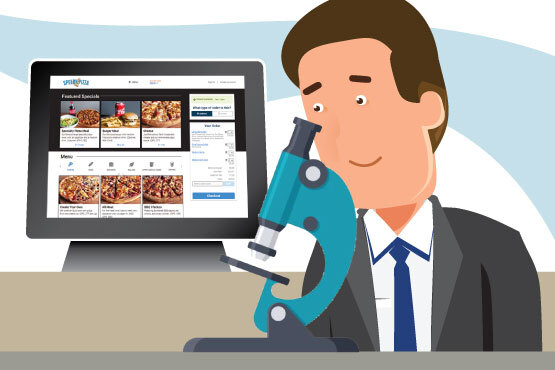Chances are your menu isn't perfect—and that's okay! Your menu should constantly evolve as the needs of your customers change. When you get comfortable, that’s usually a good indicator that it’s time for a refresh. Instead of one massive overhaul to your online menu, consider incremental changes. If the idea of increasing engagement and driving sales through data-driven decisions sounds like something your restaurant could benefit from (of course it does), keep reading.
Pick a Starting Point
Decide what you’d like to improve first, whether you’re losing customers or sales projections are consistently not meeting expectations. Consider why this might be or how you could shift the needle to improve it. Finally, set a goal with measurable performance metrics to determine if your hypothesis is correct or if it’s back to the drawing board.
Restaurant Menu Engineering Example
Miriam notices that breadstick sales through her online ordering site are significantly lower than with dine-in purchases, where they are a consistent best-seller. She thinks customers aren’t ordering the breadsticks online because the image isn't as appetizing as it could be, which may be an unintended deterrent. She decides to try replacing the image with a new, professionally curated photograph for one month to see if this will boost sales by at least 5% compared to average earnings in that same timeframe.

Limit each of your tests to one measurable change—otherwise, you won’t be able to identify the source of the results (good or bad)!
Common Areas of Optimization
If you’re having trouble pinpointing a place to start your menu engineering analysis, consider one of these common points of friction:
- Menu navigation: In one study, 37% of respondents said difficulty navigating the website’s menu was enough to make them abandon their cart.
- Menu descriptions: According to Cornell University, using descriptive words in your menu can boost sales by 27%.
- Colors & contrast: There is a vast science behind the psychology of colors, and where you should use and avoid certain ones.
- Images: Something as simple as adding quality images to your menu items can increase sales by as much as 30%.
- Order of dishes: This is another area where psychology plays an important role. For example, restaurant owners will often place their highest-priced dish first (so that everything else below will seem like a good deal).

See how SpeedLine’s integrated online ordering site SpeedDine helped NYPD Pizza Hunter's Creek increase online orders by 9% in two months.
Test Your Menu
Now that you’ve flushed out your hypothesis, goal, and performance metrics, it’s time to put it to the test! Pick a timeframe that’s likely to be consistent with your historical data. (The holiday season, for example, would not be logical for most tests since it falls outside of normal ordering metrics.) Next, select a timeframe to test your challenger (idea) that provides you with enough data to measure against your control (original menu design). Most experts recommend at least one month.
Analyze Your Results
Now comes the exciting part: measuring your results. SpeedLine’s Cloud Reporting & Analytics allows you to access your key metrics and easily drill into underlying data for deeper insights. Filter your data by time period, store locations, and compare data side by side before exporting your reports to any format you need, like Excel, CSV, or PDF. For example, if you were running a test to optimize a Friday Family Meal coupon, the Coupon and Discounts Dashboard summarizes coupon performance and other discounts that have been used/given. Here, you can see your highest-performing coupons, average coupon value, discount totals, comps, voids, and credits issued and used. You can even map how coupons are being used across your market area to further hone your marketing efforts.
Do it All Again
Any result is a lesson learned. If you experienced the positive change that you expected, then you’ve improved your website and understand why; you can begin applying this tactic to other parts of your menu. If your results were unexpected, you may have some more digging to do, but it ultimately teaches you an important lesson about customer behavior and menu dynamics.
As you continue to optimize your online menu, consider how these changes could unexpectedly impact areas of performance. Going back to our breadsticks example again, adding a professional photograph to this dish may have increased sales, but unintentionally resulted in a decrease in sales for other appetizers. If this change is significant enough, it will need to be accounted for as a secondary metric that you’ll need to measure as you continue conducting your tests.
Conclusion
Your customers’ expectations are constantly evolving. You should continuously optimize your restaurant’s online menu to reflect these needs. Adding seasonal menu items, coupons and discounts, optimizing upselling and cross-selling prompts, and testing new dishes are all excellent examples of how you can hone your online menu. In addition to enhancing the overall customer experience, it’s also an important tool for optimizing engagement, driving sales, and making informed, data-driven decisions. It’s time to take indecision off the menu and add some flavor to your restaurant’s online menu strategy.
To learn more about how menu engineering can help you optimize your online ordering services, read 8 Steps to Hone Your Online Menu for Deliveries.
Posted on Wed, Jun 14, 2023 @ 07:06 AM.
Updated on June 14, 2023 @ 2:00 PM PST.


